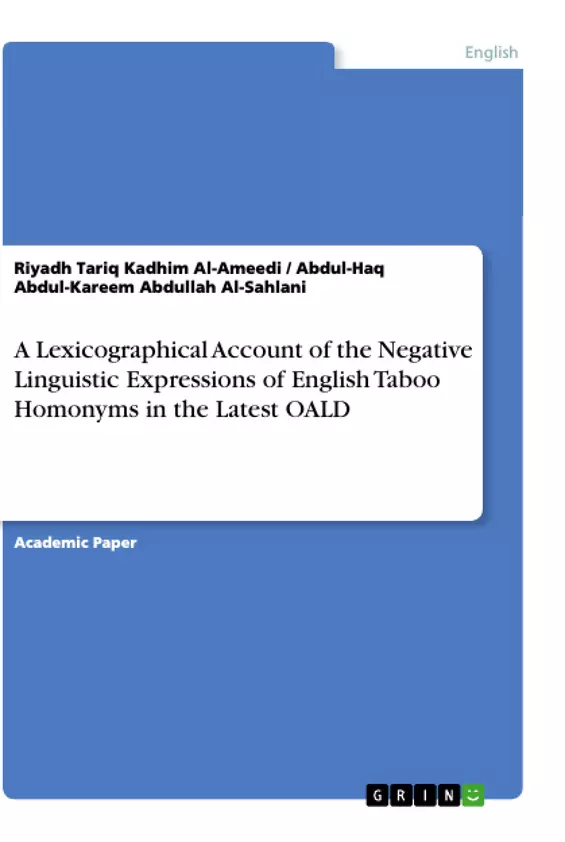This paper is an attempt at detecting the 30 most frequent ‘Taboo Homonyms’ in the latest Oxford Advanced Learner’s Dictionary, henceforth OALD, 10th edition. Three hypotheses have been included in this regard. First, taboo can be carried not only by the semantic level but by many other levels, such as pragmatics, phonology, phonetics. This can certainly be applicable to the phenomenon of homonymy. Second, semantic change may lead to turning some homonyms into taboo words. Thirdly, taking a sociolinguistic differentiation among linguistic forms into account, taboo affects all types of words regardless of their origins, formality, the domain in which they are utilized, and the speech community that are using them. Measuring the negative linguistic expressions of taboo homonyms, the use of the ABC-hypothesis of taboo words, proposed by Rosenberg et al. (2017), is adopted here so that a clear-cut distinction can be made on three levels: very offensive, offensive and disapproving taboo homonyms. Not to mention time, which plays a considerable role in the change of norms and standards of the taboo use, e.g., what is taboo today may not be taboo tomorrow.
Following the real fact that people vary the style of speaking to fit the occasion, they often avoid using certain vocabularies that may offend others or arouse their disapproval or may intentionally use these expressions for some reason. A salient instance of such avoidance is the use of taboo words and phrases. In all societies, there are taboo words that are avoided because they are felt to give bad realization to what they refer to. The extent to which such words are used varies generally between cultures.
Inhaltsverzeichnis (Table of Contents)
- Abstract
- Introduction
- Literature Review: Some Issues Concerning Taboo vs. Homonyms
- The Notion of Taboo
- Taboo Definitions
- Methodology
- Research Design
- Data Collection and Analysis
- Reliability of Data Source
- Data Graphs
- Data Analysis and Result
- Conclusions
- References
Zielsetzung und Themenschwerpunkte (Objectives and Key Themes)
This paper aims to investigate the negative linguistic expressions of taboo homonyms in the latest edition of the Oxford Advanced Learner's Dictionary (OALD), focusing on the 30 most frequent taboo words. The study aims to analyze the impact of taboo expressions on their negative senses, the influence of taboo on the entire meaning of these words, and the role of time and social norms in shaping taboo language.
- The relationship between taboo and homonymy
- The effect of taboo expressions on the negative senses of words and their influence on positive meanings
- The influence of linguistic heterogeneity on the use of language by society
- The role of social taboos in language behavior and their impact on meaning
- The use of euphemism and circumlocutions to address the impact of taboo expressions
Zusammenfassung der Kapitel (Chapter Summaries)
- Introduction: This chapter introduces the concept of taboo words and homonyms, highlighting their significance in language and communication. It also establishes the research problem and questions that will be explored in the paper.
- Literature Review: Some Issues Concerning Taboo vs. Homonyms: This chapter provides an overview of taboo concepts, its types, and its relationship with other terms, specifically focusing on homonymy. It explores different viewpoints on taboo definitions and its role in language change and social dynamics.
- Methodology: This chapter outlines the research design, data collection and analysis methods, the reliability of the data source, and the use of WordSmith Tools for analysis.
Schlüsselwörter (Keywords)
The main keywords and focus topics of the text include lexicography, taboo, homonymy, WordSmith Tools, negative linguistic expressions, taboo homonyms, ABC-hypothesis of taboo words, euphemism, circumlocutions, social taboos, language behavior, and semantic change.
- Citar trabajo
- Prof. Dr. Riyadh Tariq Kadhim Al-Ameedi (Autor), Abdul-Haq Abdul-Kareem Abdullah Al-Sahlani (Autor), 2021, A Lexicographical Account of the Negative Linguistic Expressions of English Taboo Homonyms in the Latest OALD, Múnich, GRIN Verlag, https://www.grin.com/document/1023668



